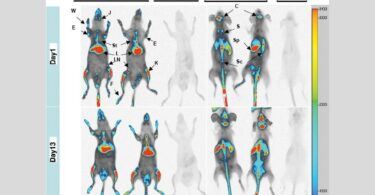Little Bit was the runt of the litter, which suited the new owners just fine. She was six weeks old but weighed only 4 pounds, even though she was from good imported working stock. In fact her siblings have all gone into police K-9 units as they have grown up.
Even though Little Bit was small, there were no obvious health problems noticed until she settled into her new home. It was then that the new caregivers noted her excessive thirst and the frequency with which she urinated.
Instead of house breaking and falling into a routine of sleeping all night, Little Bit established a habit of having to go outside to urinate at 2:00AM every night. She would produce large volumes of clear urine but did not seem to be distressed by urgency or discomfort, so they thought little about it at the time.
It was not until the time to have Little Bit spayed that the true nature of her health problems came to life. On the pre-surgical blood tests, evidence of severe kidney problems were found. Because of these extreme blood values at such an early age, Little Bit was diagnosed with congenital renal aplasia (a birth defect in which the kidneys are either absent or are poorly formed and partially functional as in Little Bit’s case.) Her surgery was cancelled and Little Bit was sent home with little hope.
(PreSurgical Lab Value Abnormals on 3/18/2008
Blood Urea Nitrogen (normal 7-27) mg/dl = 109
Creatinine (normal 0.5-1.8) mg/dl = 6
Phosphorus (normal 2.5-6.8) mg/dl = 9.8
Results of the urinalysis were not included)
At this time her conventional veterinarian did start her on Calcium acetate to help balance the high levels of phosphorus and Azodyl to help lower the BUN.
Because Little Bit was given no hope for survival and no options for conventional therapy (other than the two supportive medications given), her caregivers sought the care of a homeopath.
Litte Bit presented to my office on 3/28/2008. Her physical size and stature at 38# were only about 1/2 to 2/3 of what was expected of a Malinois of nine months of age. Because of her renal condition and her poor appetite, she was severely underweight with poor muscle tone and a generally scruffy appearance.
Based on the information gathered during her intake, the following analysis was performed:
1 GENERALS – DEVELOPMENT – arrested
2 STOMACH – THIRST – large quantities, for – often; and
3 GENERALS – FOOD and DRINKS – indigestible things – desire
4 GENERALS – FOOD and DRINKS – ice – desire
5 URINE – WATERY, clear as water
6 STOMACH – APPETITE – wanting – thirst – with
This analysis gave the following as the most likely remedies for Little Bit:
Bryonia, Calcarea, Sulphur, Phosphorus, Natrum muriaticum, Calcarea phosphorica, Lac vaccinum defloratum, Ferrum, Aconite, Belladonna, and Silicea.
Of the top 5 remedies only Calcarea and Phosphorus seemed to have much in common with the patient. Still neither was a very good match. It was not until I read the remedy Calcarea phosphorica that I found what I felt was a good match for Little Bit.
In Calc phos was the faulty development of Calcarea and the emaciation of Phosphorus. Calc phos also contained the description of the thirst and the urinary issues as well as the 2AM time modality for urination.
Little Bit was given Calc phos 1M in a single dose to be followed with daily doses of Calc phos 12c, after an assessment of the action of the initial dose. She was also converted to a home prepared raw diet, so that her protein intake was more appropriate than she would get from a processed food. In addition to the remedy she was given Milk Thistle tincture as a liver support and probiotics to support her through the diet transition.
Over the next four months, Little Bit’s BUN dropped as low as 84, her Creatinine as low as 3.4 and her Phosphorus as low as 6.4. More importantly, her appetite improved and she began to gain weight and to grow.
After two months of daily Calc phos 12c, the schedule was shifted to weekly dosing Because of a vomiting and diarrhea issue associated with each re- dose, we suspected the daily dosing was causing an aggravation. At intervals longer than 7 days, we began to see Little Bit’s energy and appetite decrease. The weekly dosing intervals have maintained steady progress without aggravation.
At last report in January, 2009, Little Bit’s caregiver reports that her lab values are at or below the values of last March and that Little Bit now weighs 45#. In addition to increased weight and energy, Little Bit now has a good hair coat with no abnormal shedding, no bad breath, and a great mood and disposition. A development that I feel is significant in Little Bit’s overall improvement is the fact that she has been in season twice at a normal six month interval, since beginning homeopathic care. Little Bit also has a 10 month old Malinois housemate who outweighs Little Bit by 13# but is not her equal in playfulness or status.
—————————————————————
Glen Dupree, DVM is a veterinary homeopath in St. Francisville, Louisiana, USA. His practice consists of homeopathic consultations and educational seminars. Dr. Dupree is launching a series of web-based seminars covering the philosophy and mechanics of veterinary homeopathy in June, 2009.
For more information, contact Dr. Dupree at dt 225.709.4381. For more information, go to homeopathyfortheanimals.com.






